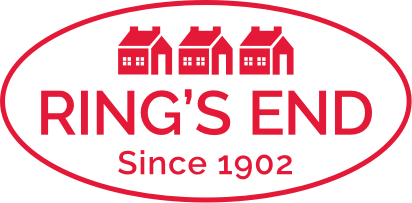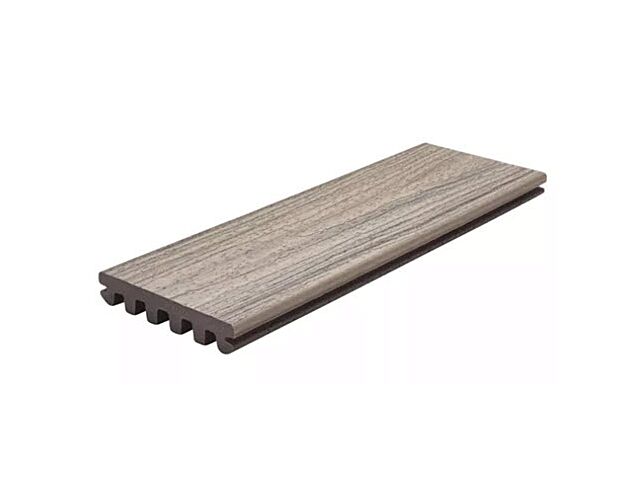Trex Composite Decking, Trex Enhance® Rocky Harbor
Enhance decking offers an authentic wood-grain appearance with the durability of composite and the affordability of wood. Enhance decking boards are scalloped, making them as lightweight as lumber—without the extra work. This long-lasting decking requires little upkeep and comes in seven colors. No outdoor living space is complete without railing that perfectly captures its surroundings. Enhance decks mix and match with all of our Trex railing lines, allowing you to create a completely custom look.Enhance decking uses 95% recycled plastic film and reclaimed sawdust, and is backed by our 25-Year Limited Residential Fade & Stain Warranty.
A contemporary changing neutral, Rocky Harbor adds sandy undertones to a rustic slate grey, featuring a low-maintenance, wood-like grain pattern.
- Made of high-performance composite; won’t rot, warp or splinter, unlike wood
- Quality low-maintenance material; cleans easily with soap and water
- Easy-to-build decking; no specialty tools required
- Backed by 25-year Limited Residential and Fade & Stain warranties
| Series/Sub-Brand | Enhance® |
|---|---|
| Type | Square & Grooved Edge |
| Size | 5/4 x 6 |
| Color | Rocky Harbor |
| Length | Multiple |
| Brand | Trex |
| Color Family | Gray |
| Finish | Variegated |
| Material | Composite |
| Actual Size | 1 in. x 5.5 in. |
| Manufacturer Code | 543072*** |
Tools Required: Cordless driver, Chalk line, Tape measure, Jig saw, Carpenter square, Spacing tools, Circular saw, Safety glasses, Drill bits, Router Bits, TigerClaw® Pneumatic Gun
Walking Surface: Like many other outdoor surfaces, such as concrete, asphalt, beach sand, wood decking, other brands of composite decking, etc., Trex decking can get hot due to weather and sun exposure. On such days, care needs to be taken to make sure skin does not have extended contact with the surface of the deck, especially with young children and those with special needs. Please note also that the darker the color, the hotter the deck will feel. For hotter climates, consumers should consider choosing a lighter color.
Static Electricity: While this is not common, static electricity can occur on walking surfaces in dry climates or in areas where dry winds and dust-borne particles lay on the decking surfaces. Static electricity can build up on occupants walking across any composite decking surface, including Trex, then produce a small static shock if they touch a grounded metal surface such as railing, door, etc.
Rubber Mats: Use caution when using rubber-backed mats (i.e. welcome mats, etc.) as these may contain substances that can sometimes discolor or lighten the decking surface.
Job Site Storage: Store decking on a flat level surface and ALWAYS use proper supports (dunnage). DO NOT store directly on the ground. When stacking decking bundles, supports (dunnage) should start approximately 8-in (203 mm) from each end and be spaced approximately 2-ft (0.61m) on center. In addition, supports (dunnage) should line up vertically/perpendicular to the decking product. Adjust support blocks (dunnage) accordingly if bundles are loose.
Safety: When working on any construction project, you should wear protective clothing and safety equipment. Wear safety glasses, gloves, a dust mask and long sleeves, particularly when cutting in confined spaces. Trex decking and railing are heavier and more flexible than wood. DO NOT try to lift the same quantity of Trex boards as you would traditional lumber.
Calculating Material Requirements: To determine how much Trex decking material you will need,
- Step 1: Determine the Square Footage of the Deck
- Step 2: Showcase the Shape of the Deck
- Not all decks are squares or rectangles. You can choose a hexagon, pentagon, octagon, or whatever shape you like within the space you have.
- Step 3: Figure Out the Square Footage of Each Board
- Trex composite deck boards are manufactured in three widths. The 1” Transcend® and Enhance® boards are .94” x 5.5” and the 1” Select® boards are .82” x 5.5”. Transcend and Select boards also are available in a 2x6 dimension, or 1.3” x 5.5”. All three decking collections come in square-edge and grooved-edge. Grooved-edge boards allow you to use the Trex Hidden Fastener for a cleaner surface appearance.
- Step 4: Understand the Length of Each Board
- The lengths of the decking boards usually range from 8’ to 20’. Trex boards come in 12’, 16’ and 20’ lengths. You’ll also need to know the length of each board to calculate the overall size of your deck.
- You'll need a saw to cut composite deck boards as you assemble your deck properly. Some boards will need to be cut at an angle to make them fit together correctly. Always leave room for extra boards, too, for the waste on the project after cutting them to the right angles and lengths.
- Step 5: Calculate the Number of Deck Boards
- Anticipate having waste on your decking project. The general rule of thumb is that you need 5% extra decking material to account for waste and mistakes. For example, if your project calls for 80 boards for 800 square feet, add another 40 square feet for waste, or four extra boards.
To determine the number of deck boards you need to build your deck:
Take the area of your deck (as shown in Step 1) and divide that number by the board area (Step 3).
Deck Depth (in inches) / Board Width (inches) = Number of deck boards needed.
0.05 x Number of deck boards needed = Total # of extra deck boards you should purchase
Total number of deck boards needed + Total number of extra deck boards = # of boards you should order
Let’s work through an example. Imagine we want to build a 20’x12’ deck using a deck board that is 5.5 inches wide and 20” in length.
First, calculate the depth in inches: 12x12 = 144 inches
Next, divide the board depth (in inches) by the board width (For most 1x6 or 2x6 boards, the width is 5.5”): 144/5.5= 26.18
Then, round up to get a whole number: 27 boards
Next, multiply the total number of deck boards needed by 0.05 to account for the additional 5% of material needed for waste. Again, round up to get a whole number 0.05 x 27 = 2 extra boards
Lastly, add the waste boards to the total. 27 + 2 = 29 boards total

